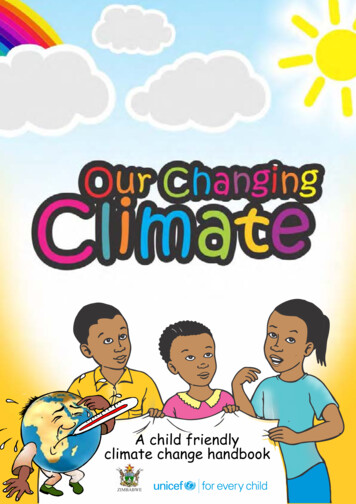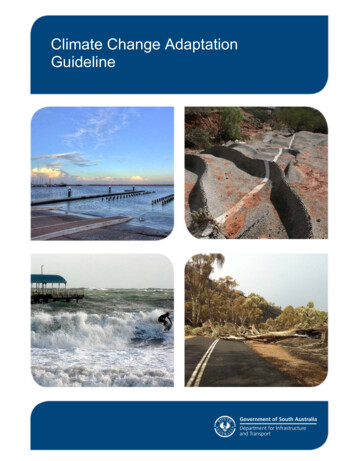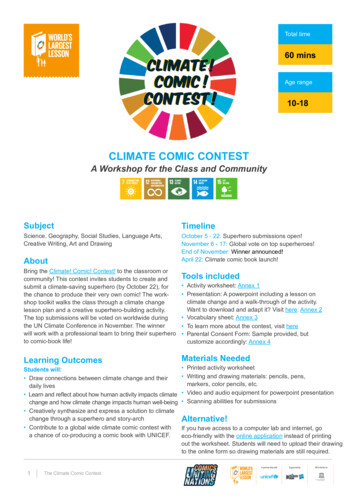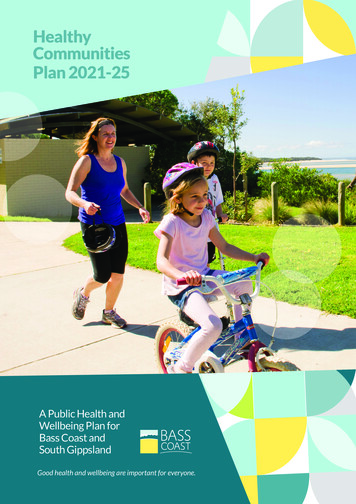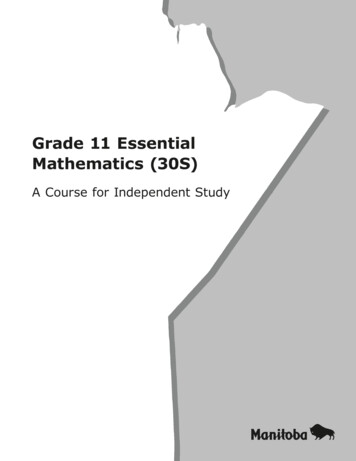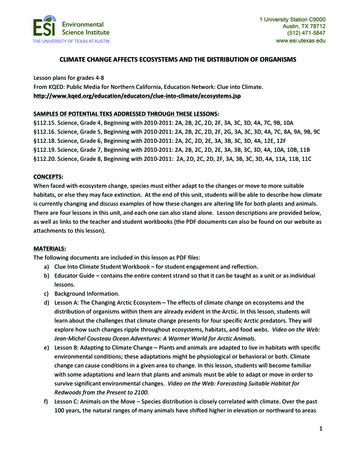
Transcription
ONOFORGANISMSLessonplansforgrades4- ducation/educators/clue- ‐into- Beginningwith2010- 16.Science,Grade5,Beginningwith2010- 9C§112.18.Science,Grade6,Beginningwith2010- .Science,Grade7,Beginningwith2010- �112.20.Science,Grade8,Beginningwith2010- ) entandreflection.b) atitcanbetaughtasaunitorasindividuallessons.c) BackgroundInformation.d) s,habitats,andfoodwebs.VideoontheWeb:Jean- cticAnimals.e) gSuitableHabitatforRedwoodsfromthePresentto2100.f) tionornorthwardtoareas1
ise.g) llsafterahands- s.2
VOCABULARYCLIMATE OVERVIEWclimate changea change inlong-termaverage weatherpatterns; can benatural or theresult of humanactivitiesFill in the blanks using the words providedclimate modela mathematicalmodel based ondata from globalcycles that driveEarth’s climatesystem thathelps scientistspredict changesin our planet’sclimate over timeecosystema system madeup of acommunity ofliving thingsinteracting withtheirenvironmentglobal warmingan averageincrease inEarth’stemperature,which in turncauses changesin climateClimate Changedescribes the average patterns of weather for anarea over a long period of time. describes thetemperature, wind, and precipitation in an area at a particular time.Over the past century, the climate has changed on Earth.Temperatures have gone up 1.2 to 1.4 degrees Fahrenheit and areexpected to continue to rise. You probably won’t notice this warmingon any particular day. Over long periods of time, however, it causesmany changes around the world.The Greenhouse EffectThere are many factors that influence how climate changes. Onefactor is the amount of in Earth’satmosphere. These gases trap the heat from the sun, causing thegreenhouse effect and warming Earth. Without these gases, Earthwould be too cold to support life. These gases includeand .Greenhouse GasesPeople have been producing a much greater amount of these gases inthe past 100 years. We produce greenhouse gases whenever we burngas in our cars and burn coal to make electricity. With moregreenhouse gases in the atmosphere, the isstronger. This makes temperatures on Earth go up.EcosystemsClimate change affects , or the living and nonlivingparts of a particular environment. When the climate changes, animalsand plants may change as well. Sometimes they havethat allow them to survive in the newconditions. Sometimes they will move, or migrate, to anotherecosystem. And sometimes, animals and plants will not be able tosurvive in the new climate, and they may become .Word bank:adaptationscarbon dioxideecosystemsextinctgreenhouse gases methaneclimategreenhouse effectweather2
VOCABULARYCLIMATE OVERVIEW CONTINUEDgreenhouseeffectEnergy(radiation) fromthe sun passesthrough theatmosphere,where most of itis absorbed byEarth. Someinfrared radiation(heat) is reflectedback into space.Greenhousegases act like ablanket, trappingsome of thisinfrared radiationand warmingEarth and itsatmosphere, aprocess calledthe greenhouseeffect.Fill in the blanks using the words providedhydrologiccyclethe continuousprocess by whichwater iscirculatedthroughout Earthand itsatmosphere;another term forthe water cyclesuitable habitatan area where agiven speciescan live becausethe area’stemperature andprecipitationlevels meet thesurvival needs ofthe speciesThe Water CycleClimate change affects the water cycle in many ways. First, when thetemperatures are warmer, , or water entering theatmosphere, happens more quickly. In some places, this can causethe land to dry out and can cause a . Warmer aircontains more . In some places, this leads tomore , or rain or snow falling. When thishappens, storms can be bigger than normal, and flooding may occur.Warmer temperatures also affect how water gets stored in its frozenform in or . When more snow and icemelt, sea levels can rise, and may occur. In addition,many people rely on melting snowpack to provide theirduring summer months. If climate changealters how much snow falls and when the snowpack melts, theamount of water that gets stored in will change too.Word bank:droughtfresh precipitationwater vaporEnergyNonrenewable energy comes from fossil fuels like ,, and and from uranium, which isused in . Fossil fuels are created over millionsof years. When these are burned to release energy, they also emitcarbon dioxide into the atmosphere. This adds to the greenhouseeffect, which makes Earth warmer.Renewable energy is energy created from resources that peoplecannot use up. The most common renewable resources are: comes from the sun turns turbines to make electricity comes from moving water comes from , or plant and animalsparts comes from Earth’s heatWord bank:bioenergybiomassgeothermal energy hydropowernatural gasnuclear powercoaloilsolar powerwind3
PEER REVIEWOnce anexperiment isdone, the work ofscience isn’tover. Otherscientists look atwhat has beendone, a processcalled peerreview. Theycheck to makesure that theexperiment waswell designedand that the datawere analyzedcorrectly. For thefindings to beaccepted, otherscientists need toget the sameresults whenthey do theexperiment. Inother words, theyneed to replicatethe results.STEM LITERACYSelected Parts of the Scientific Process: Scientists develop a question about how the world works.Scientists make a hypothesis—an educated guess or proposedexplanation—about how something works.Scientists design an experiment to test their hypothesis.Scientists collect data from their experiment.Scientists analyze the results from their experiment and revisetheir experiment if necessary.Scientists draw conclusions from their experiment andcommunicate their results.Design Your Own ExperimentQuestion:Hypothesis:Data and Observations:Results:Review one ofyour classmate’sexperiments. Doyou think theirexperiment andfindings makesense? Why orwhy not?Conclusions:Notes4
MEDIA LITERACYSCIENCEMEDIAMake a list oftypes of sciencemedia.How reliable are your sources about science? Pick an article, radiostory, video, or website to analyze below:Media:Who made this?Why did they make it?What information or perspective is not included?Who benefits from this piece? Who could be harmed?Notes5
TAKINGACTIONHere are someexamples ofways to reduceyour impact onclimate change: Travel byfoot, bike, orskateboardinstead ofcar.Replace yourold lightbulbswith compactfluorescentlights (CFLs)that use lessenergy.Recycle yourpaper, metal,and plastic.Bring yourown bags tothe grocerystore.CLIMATE CAREERSI’m a science journalist. Iwrite about climate change.I’m a botanist. Istudy how differentplants move whenthe climatechanges.I’m a paleoclimatologist. I studyice cores in the Arctic to find outabout what Earth’s climate waslike long ago.I’m a meteorologist.I study hurricanes.I’m an atmospheric chemist. I studyhow gases interact in theatmosphere.I’m a biologist. I studyclimate change andthe rain forest.I’m an economist. Ipredict how climatechange affects tradeand economicdevelopment.I’m a geologist. Ilook for sourcesof geothermalenergy.I’m anastronomer. Istudy the sun’seffects onclimate.I’m an oceanographer. Istudy how climatechange affects oceanecosystems.I’m acomputerscientist. Icreateclimatemodels.I’m anagriculturalscientist. Istudy howclimate affectsthe growth ofcrops.Here are some examples of climate careers. Which of these careers ismost interesting to you? Why?6
TAKINGACTIONHere are someother examplesof ways toreduce yourimpact onclimate change: Plant trees inyour yard. Use a powerstrip for yourTV andchargers, andturn it offwhen youdon’t need it. Use publictransporttation orcarpool. Teach otherswhat you’velearned, sothey canmakeinformedchoices.GLOBAL IMPACTHow will climate change affect different parts of the world? Use thisspace to record notes about changes around the globe.Notes7
CLIMATE PLEDGEPick three things you plan to do to reduce your impact on climatechange. How will you help?In order to reduce my impact on climate change, I pledge to:1.2.3.Your Signature8
Strand 2 Educator Guide – Climate Change Affects Ecosystems and the Distribution of OrganismsSUBJECTLife ScienceGRADE LEVELS4–8OVERVIEWIn this strand, students learn how changes in climate affect the distribution oforganisms in ecosystems around the world. By the conclusion of these lessons,students will be able to describe how climate is currently changing and to provideexamples of how these changes are altering life for both plants and animals. Theywill appreciate that when faced with ecosystem change, species must either adapt tothe changes or move to more suitable habitats, or else they may face extinction.Through examples ranging from the ice pack of the Arctic to the mountains ofCalifornia to tide pools along the coast, students will understand that if climatechange occurs as predicted, it will have a profound influence on the distribution andsurvival of species on Earth. In order to complete this unit, students should alreadyunderstand food chains and how organisms interact within an ecosystem.STRAND UNIT PLANWeek1MondayLesson 2a:Activity 1TuesdayLesson 2a:Activity 2,GlobalImpactDiscussion2What CanWe Do atSchool?Planningthe NativePlantGardenWhat CanWe Do atSchool?Installingthe NativePlantGardenLesson 2c:Activity 13Lesson 2d:Activity 2(Note:continueexperimentfor sixweeks)WednesdayExploreYour Earth:Walk inSchoolyardor LocalParkLesson 2c:Activity 2,MediaLiteracyDiscussionThursdayLesson 2b:Activity 1FridayLesson 2b:Activity 2,STEMLiteracyDiscussionField Trip:Visit Zoo,BotanicalGarden, orAquariumLesson 2d:Activity ntor Review forTraditionalAssessmentCompleteand ShareAlternativeAssessmentor GiveTraditionalAssessment1
EXPLOREYOUR EARTHTake a walk aroundyour schoolyard. Doyou think the plantsthere will be affectedby climate change?Why or why not? If thekinds of plants thatsurvive there change,how will this affectanimals in yourschoolyardecosystems?Visit a local park.Record animal andplant observations.How might the foodwebs at your local parkbe affected bychangingtemperatures? Canyou find any evidenceof changes alreadytaking place?STRAND ESSENTIAL QUESTIONS1. How does climate change affect ecosystems?2. How does climate change affect the survival and distribution of organisms?LITERACY CONNECTIONSLessonLesson 2a: The ChangingArctic EcosystemLesson 2b: Adapting toClimate ChangeLesson 2c: Animals on theMoveLesson 2d: Plants in CareersXXXSTRAND ASSESSMENT IDEAS1. Strand 2 Traditional Assessment (attached)This test uses multiple choice and short-answer questions to assess studentlearning for the entire strand.2. Strand 2 Alternative Assessment: Zoo/Botanical Garden Information PanelZoos and botanical gardens educate the public about issues regarding thespecies in their care. How will these species fare if our climate continues towarm? In this assessment, students select an animal or plant species to research,then design an informational panel that might be displayed in front of theirspecies’ exhibit at a zoo or botanical garden. Students examine the species’habitat, role in the food chain, and potential fate in the face of climate change,then design an information panel to teach the public about how climate changemight affect the chosen species.Students should examine the following topics in their research:a) Habitat: Where does your plant or animal live? How large is its range? Whatis the climate of the habitat?b) Ecosystem: What is your species’ role in the ecosystem? What does it eatand/or what eats it?c) Climate change: How will climate change affect the plant’s/animal’s habitat?How will changes affect the species’ food web? Do members of this specieshave adaptations that will allow them to survive or thrive in the new climate?Can this organism move to other suitable habitats? What is this species’ likelyfate in the face of climate change?2
SCIENCE STANDARDSLessonCalifornia State ScienceContent Standards,Grades 4–8Lesson 2a:The ChangingArcticEcosystemGrade 4: Life Sciences. 3.Living organisms dependon one another and ontheir environment forsurvival. (3.b.)Grade 6: Ecology (LifeSciences) 5.Organisms in ecosystemsexchange energy andnutrients amongthemselves and with theenvironment. (5.e.)Lesson 2b:Adapting toClimateChangeGrade 4: Life Sciences. 3.Living organisms dependon one another and ontheir environment forsurvival. (3.b.)Grade 6: Ecology (LifeSciences) 5.Organisms in ecosystemsexchange energy andnutrients amongthemselves and with theenvironment. (5.e.)Grade 7: Evolution. 3.Biological evolutionaccounts for the diversityof species developedthrough gradual processesover many ciples andConceptsPeople InfluenceNatural Systems(Concept a)National ScienceEducationStandards forMiddle SchoolLife Science:Populations andecosystemsThere are noPermanent orImpermeableBoundaries thatPrevent Matterfrom Flowingbetween Systems(Concepts b, c)People InfluenceNatural Systems(Concept a)There are noPermanent orImpermeableBoundaries thatPrevent Matterfrom Flowingbetween Systems(Concepts b, c)Earth ScienceLiteracyPrinciplesThe EssentialPrinciples ofClimate LiteracyBig Idea 3: Earthis a complexsystem ofinteracting rock,water, air, and life.(3.5, 3.6, 3.7, 3.8)Principle #3: Lifeon Earth dependson, is shaped by,and affectsclimate. (C)Principle #7:Climate changewill haveconsequences forthe Earth systemand human lives.(E)Life Science:Diversity andadaptations oforganismsUnifying Conceptsand Processes:Evidence, modelsand explanationBig Idea #3: Earthis a complexsystem ofinteracting rock,water, air, and life.(3.6, 3.7, 3.8)Big Idea #9:Humanssignificantly alterthe Earth.(9.3)Principle #3: Lifeon Earth dependson, is shaped by,and affectsclimate. (A, C)Principle #5: Ourunderstanding ofthe climatesystem isimproved throughobservations,theoreticalstudies, andmodeling. (A, B,C)Principle #7:Climate changewill haveconsequences forthe Earth systemand human lives.(E)3
LessonCalifornia State ScienceContent Standards,Grades 4–8Lesson 2c:Animals onthe MoveGrade 4: Life Sciences. 3.Living organisms dependon one another and ontheir environment forsurvival. (3.b.)Grade 6: Ecology (LifeSciences) 5.Organisms in ecosystemsexchange energy andnutrients amongthemselves and with theenvironment. (5.e.)Lesson 2d:Plants in PerilGrade 7: Evolution. 3.Biological evolutionaccounts for the diversityof species developedthrough gradual processesover many generations.(3.e.)Grade 4: Life Sciences. 3.Living organisms dependon one another and ontheir environment forsurvival. (3.b.)Grade 6: Ecology (LifeSciences) 5.Organisms in ecosystemsexchange energy andnutrients amongthemselves and with theenvironment. (5.e.)Grade 7: Evolution. 3.Biological evolutionaccounts for the diversityof species developedthrough gradual processesover many ciples andConceptsPeople InfluenceNatural Systems(Concept a)National ScienceEducationStandards forMiddle SchoolLife Science:Diversity andadaptations oforganismsThere are noPermanent orImpermeableBoundaries thatPrevent Matterfrom Flowingbetween Systems(Concepts b, c)People InfluenceNatural Systems(Concept a)There are noPermanent orImpermeableBoundaries thatPrevent Matterfrom Flowingbetween Systems(Concepts b, c)Earth ScienceLiteracyPrinciplesThe EssentialPrinciples ofClimate LiteracyBig Idea #3: Earthis a complexsystem ofinteracting rock,water, air, and life.(3.6, 3.7, 3.8)Principle #3: Lifeon Earth dependson, is shaped by,and affectsclimate. (A, C)Big Idea #9:Humanssignificantly alterthe Earth.(9.3)Life Science:Diversity andadaptations oforganismsBig Idea #3: Earthis a complexsystem ofinteracting rock,water, air, and life.(3.6, 3.7, 3.8)Big Idea #9:Humanssignificantly alterthe Earth.(9.3)Principle #7:Climate changewill haveconsequences forthe Earth systemand human lives.(E)Principle #3: Lifeon Earth dependson, is shaped by,and affectsclimate. (A, C)Principle #7:Climate changewill haveconsequences forthe Earth systemand human lives.(E)DecisionsAffectingResources andNatural Systemsare Complex andInvolve ManyFactors (Concepta)4
WHAT CAN WEDO ATSCHOOL?As native plants loseprecious habitat due toclimate change andhuman activities, theymay be at risk ofextinction in your state.Plant a native plant orinstall a native plantgarden at your school,researching whichplants are native toyour state and willsurvive best in yourclimate. Will yourgarden serve ashabitat for animals aswell? Consider how tosupport species, suchas butterflies or birds,that rely on nativeplants for survival.INTERDISCIPLINARY CONNECTIONS (CA CONTENT STANDARDS)LessonLesson 2a: TheChanging ArcticEcosystemLesson 2b: Adaptingto Climate ChangeLesson 2c: Animalson the MoveLesson 2d: Plants inPerilEnglish Language ArtsGrade 4:1.0. Listening andSpeaking Strategies;Comprehension (1.1, 1.2)Grade 6: 1.0. WritingStrategies Research andTechnology (1.4)Grade 6: 2.0 WritingApplications (Genres andTheir Characteristics);Expository Compositions (2.2)Grade 6: 2.0 WritingApplications (Genres andTheir Characteristics);Narratives (2.1)Visual and PerformingArtsGrade 4: 5.0.Connecting and applyingwhat is learned in the visualarts to other art forms andsubject areas and to careers(5.3. Visual Literacy)Grade 4: 5.0.Connecting and applyingwhat is learned in the visualarts to other art forms andsubject areas and to careers(5.3. Visual Literacy)Grade 4:1.0. Listening andSpeaking Strategies;Comprehension (1.1, 1.2)5
ABOUT THEAUTHORSTRAND 2 ASSESSMENT ANSWER KEY1. C2. C3. B4. A5. C6. B7. A8. D9. C10. A11. Answers will vary. Sample answer: In the Arctic, the Arctic fox is a predator thateats lemmings. In warmer temperatures, the population of lemmings goes down,which reduces the amount of food available for Arctic foxes. In addition, warmertemperatures have caused the range of the red fox to increase, and it nowcompetes with the Arctic fox for food.12. Answers will vary. Sample answer: The cactus has several adaptations to help itsurvive in a dry climate. It has a thick waxy coating that prevents evaporation ofwater, and it has long taproots to reach deeper sources of water during the driestmonths.13. Answers will vary. Sample answer: An animal that has more time to gather foodbefore winter will be more likely to survive through winter. As temperatures warm,the food-collecting season gets longer. Scientists have found that somemosquitoes have evolved the adaptation of going dormant later, which allowsthem to take advantage of the longer summer to gather food.Laura Hodder is aneducation writer basedin San Francisco. Shehas worked as an authorfor the CaliforniaEducation and theEnvironment Initiativeand is a former middleschool math and scienceteacher.KQED EducationNetwork engages withcommunity andeducationalorganizations to broadenand deepen the impactof KQED media to effectpositive change.www.kqed.org/educationSUPPORTFunding for “Clue intoClimate: A DigitalMedia-BasedCurriculum Unit onClimate Change” wasprovided by theCorporation forPublic Broadcasting.ADDITIONAL RESOURCES (SPECIFIC TO THE BAY AREA) The San Francisco Zoo and the Oakland Zoo offer collections of animals fromaround the world. Take a field trip to see a variety of species and explore howdifferent animals may respond to climate in their unique habitats.www.sfzoo.org, www.oaklandzoo.org How do different plants survive in a particular climate? Compare the plants fromMediterranean climates around the world at the San Francisco BotanicalGarden at Strybing Arboretum. www.sfbotanicalgarden.org Participate in the Expanding Oceans classroom program at San Francisco’sAquarium of the Bay, in which students participate in hands-on experimentsexploring how rising sea levels will affect ecosystems in the San Francisco Bay.www.aquariumofthebay.org6
STRAND 2 ASSESSMENTPAGE 1Multiple Choice (1 point each)1. How have habitats changed in response to climate change over the past few decades?a. On average, temperatures are decreasing and habitats are getting wetter.b. On average, temperatures are decreasing and habitats are getting drier.c. On average, temperatures are increasing. Some habitats are getting wetter and some are getting drier.2. How has climate change affected the Arctic ice pack?a. The ice pack has increased, mainly due to cooler temperatures.b. The ice pack has increased, mainly due to increased amounts of snow.c. The ice pack has decreased, mainly due to warmer temperatures.d. The ice pack has remained relatively constant.3. Which of these will cause an animal population to increase?a. The population of the animal’s prey decreases.b. The population of predators that feed on this animal decreases.c. The animal’s season for hunting food gets shorter.4. Which animals are least likely to be able to survive climate change?a. Animals that have a small suitable habitatb. Animals that can move to new habitats easilyc. Animals that can survive at a variety of temperaturesd. Animals that can eat a variety of different foods5. What is likely to happen to wolverines if climate change continues at its current pace?a. They will adapt to the new conditions and become a new species.b. They will easily move to habitats with cooler climates.c. They will not be able to survive in many of their former habitats.d. They will thrive in the warmer climate.6. In the early 1900s, Joseph Grinnell visited land in Yosemite to study the wildlife there. When scientistsreturned recently, what changes did they find?a. Glaciers in Yosemite had increased in size.b. Several species of small mammals that used to live at a variety of elevations are no longer found at lowerelevations.c. The range of small mammals had increased.d. Most small mammal species developed adaptations to the warmer temperatures.7. How has an increase in average temperatures affected animals and plants that live on the coast?a. Some animals and plants are moving north to new habitats.b. Tide pool ecosystems are getting bigger.c. The sea level is dropping, increasing the size of marshes.d. Most animals and plants that live in tide pools have already become extinct.8. What happens when an animal moves to a new habitat?a. It may become a competitor with animals that already live there.b. It may become a predator for animals that already live there.c. It may become prey for predators that already live there.d. All of the above.7
STRAND 2 ASSESSMENTPAGE 29. What do climate models predict will happen to native plant species in California?a. Plants will move to lower elevations.b. Plants will move to the south.c. About two-thirds of native plants may lose much of their habitat.10. What is the main difference between the way plants and animals respond to climate change?a. Although both animals and plants can move their range, animals can do it within a single generation. Plants moveover multiple generations.b. Animals evolve faster than plants, so they can develop adaptations to changing climate more rapidly.c. Plants are more dependent on seasonal changes than animals, so changes in seasons affect them more.Short Answer (2 points each)11. Pick an ecosystem. Identify one predator and its food source that live in this ecosystem. How might climate changeaffect these species?12. Pick a species. What adaptations help that species survive in its suitable habitat?13. Give an example of an adaptation in either a plant or an animal that could result from increasing temperatures.8
Strand 2 Background ArticleClimate Change Affects Ecosystems and the Distribution of OrganismsSECTIONTOPICS What anecosystem is(interconnectednature ofspecies) How climatechange affectsecosystems andthe organismswithin themoChanges intemperatureoChanges toseasonalevents (whento mate,migrate,hibernate) andgrowingseasons(when tobloom, shedseeds)oChanges toone speciesaffects otherorganismswithin anecosystemCLIMATE CHANGE AND ECOSYSTEMSIn the past 100 years, Earth’s surface temperature has increased an average of 1.2to 1.4 degrees Fahrenheit, and climate models suggest that without changes tohuman activities, global surface temperatures will rise an estimated 3 to 7 degreesFahrenheit by the end of the century. This warming of the atmosphere and oceanswill alter climate patterns for diverse ecosystems around the world and affect thesurvival of millions of species.Ecosystems are communities of living organisms interacting with the environmentin which they live. When scientists discuss ecosystems, they emphasize theinterconnected nature of the abiotic factors (nonliving variables such as soilcomposition, water, and temperature) and the biotic factors (living componentssuch as plants, animals, and microbes) within these systems. For example, anincrease in average temperature in an ecosystem may alter precipitation and windpatterns. This could lead to water levels rising or soil chemistry changing. As theabiotic conditions of a habitat change, so do the chances of survival of the speciesthat live there. Some may thrive and others may struggle, but either kind of changeto one population inevitably affects others, as organisms are linked through thefood web and the various services, such as pollination or shelter, that they provideto one another. Ecosystems are complicated, and any change to one part will affectmany others.To understand how climate change may affect an ecosystem, consider an estuary.Warmer temperatures are expected to bring both increased precipitation (in someplaces) and rising sea levels. Increased precipitation causes increased river flowvolume, allowing for more freshwater to enter an estuary at its head. Higher sealevels push more salt water into the mouth of the estuary. As a result, the zone oftransition from riverine freshwater to oceanic saltwater could be “squeezed” on bothends—the estuary shrinks. This could have a wide range of effects on the animalsand plants within the estuarine ecosystem.Changes in climate can affect species throughout an ecosystem. Some responddirectly to temperature increases. For example, mussels cannot survive in waterthat gets too warm, and polar bears have no place to rest between hunting tripswhen sea ice melts. Changing temperatures can lead to new precipitation patterns,such as drought in the Sahel in Africa, which has killed many plants and threatenedthe survival of humans and other animals that depend on the plants fornourishment. Many species rely on temperature cues to direct seasonal activity,such as migration, mating, and hibernation in animals and when to flower andproduce seeds in plants. Of course, since species are so interdependent inecosystems, the changing of a seasonal pattern for one species may alter the lifeof another. For example, if a flower blooms before insects have come out ofdormancy, pollination cannot happen. If a bird migrates before plants haveproduced food for them to eat, they ris
Lesson!plans!forgrades!428! cationNetwork:!Clue!intoClimate. . environment global warming an average increase in Earth’s temperature, which in turn causes changes . or the living and nonliving parts of a pa



